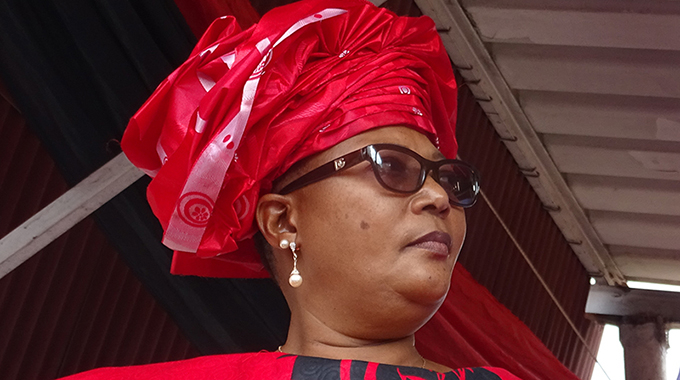Justice system guaranteeing children’s rights in climate change issues needed

Gibson Mhaka, Senior Features Reporter
IN Ngangu Village, Chimanimani District, Manicaland Province Ellen Dhliwayo’s 11-year-old boy is crying because he is hungry. He is not going to school and is spending his days with his mother at Garikai camp, where thousands are living in tents after their homes were destroyed by Cyclone Idai last year.
And, in Nsungwale area under Chief Sinakoma in Binga District, Matabeleland North, Agnes Munkuli is worried about her nine-year-old girl who is very weak. She is struggling to survive and is pleading for food after all her crops and animals were swept away by the floods experienced in the area early this year.
Dhliwayo and Munkuli’s stories are sadly not unique. Their problems are felt across the country were thousands of children suffer the impacts of poverty, inequality and exclusion disproportionately, often with severe lifelong consequences, due to their sensitive phase of life and development.
Their plight is also an indication of how effects of climate change such as diseases, droughts and floods are destroying food sources and livelihoods and further exacerbated risks to children and deepened deprivation for millions.
Studies have shown that there may be no greater, growing threat facing the world’s children today than climate change. Children are suffering disproportionately from climate change and growing environmental risks.
As escalating droughts and flooding degrade food production, children will bear the greatest burden of hunger and malnutrition. The dangers of climate change and environmental degradation are more pronounced for children than for adults. This is because they are less equipped physically, mentally and emotionally to cope with life-threatening conditions. Violations of their rights resulting from climate change and environmental harm can have irreversible, lifelong and even transgenerational consequences.
According to a report by World Vision, children living in developing countries face the greatest risks of all, not because climate change effects will be any worse there than in other countries, but because poverty limits their ability to respond.
At times the challenge imposed by environmental instability starts before the child is even born. Exposure to extreme heat, air pollution, and increased rates of infection during pregnancy has been associated with poorly developed lungs, prematurity, stillbirth, brain abnormalities, heart abnormalities, and increased incidence of neurodevelopmental disorders. Children and young people from vulnerable communities are particularly at the core of the exposure risk.
This mounting global crisis has the potential to undermine many of the gains that have been made in child survival and development — and poses even greater dangers ahead. This is most evident in developing countries like Zimbabwe where there is no child-sensitive climate policy to address children’s specific risks and vulnerabilities to the effects of climate change. Climate change acts as a threat multiplier, compounding problems caused by environmental harm or degradation.
It thus calls upon governments particularly those in developing countries to promote the development and implementation of children’s right to information in environmental matters, and education for them to adapt to the immediate challenges of climate change as well as to understand the role that they will be called on to play.
Access to climate change and environmental information is essential to the protection of children’s rights to health, food, water and housing. Furthermore, children depend on information to be able to exercise their rights to freedom of expression, to be heard and participate in environmental matters.
The status of children’s environmental health is also closely linked to other rights. These include the rights to life, survival and development, food, water and sanitation, adequate housing, education, freedom from economic exploitation, information, and an adequate standard of living. The right to equality and non-discrimination implies that all children should have access to a healthy and safe environment.
Strict implementation for an environmental justice system which guarantees access to remedy for environmental child rights is needed in developing countries like Zimbabwe. That call was highlighted by the Zimbabwe Environmental Law Association (ZELA), in its press statement to mark the 2020 Day of the African Child (DAC) which was celebrated on June 16.
ZELA is a public interest environmental law organisation which seeks to promote environmental justice and sustainable utilisation of natural resources and has been working to promote environmental child rights particularly in mining communities.
ZELA says this year’s DAC theme: “Access to a child friendly justice system in Africa,” resonated very well with their work on environmental child rights.
“We believe that one of the core components of environmental child rights is access to effective remedies when children’s environmental rights are threatened or violated. As a public interest environmental law organisation we thus call for an environmental justice system which guarantees access to remedy for environmental child rights violations taking into consideration the need for children to participate and access information, considering their level of understanding and of particular interest the best interests of the child,” the statement reads in part.
Though a major player in Zimbabwe’s economy, mining was cited by ZELA as one of the main causes of environmental degradation in the country.
From ZELA’s observation, children’s right to information does not always receive adequate attention in laws and policies related to the environment, whether at the international or the national level. This is despite the fact that the Convention on the Rights of the Child expressly outlines the necessity of a safe and healthy environment for children to thrive.
The 2030 Sustainable Development Goals (SDGs) also represent a global commitment to securing a bright future for the world’s children, and are a crucial opportunity to realise their rights in all countries.
Children everywhere suffer violations of their rights to life, development, health, food, water, education, culture, play and other rights because governments fail to protect the natural environment. Both children and the environment are perceived as objects of protection, which significantly limits children’s influence on decision-making.
According to child parliamentarians and environmental child rights activists, getting involved in nature conservation is one of the foremost ways for children to protect and realise their rights in the context of the environment. Their right to participation includes having the right to be heard and taken seriously by governments on different levels in regard to environmental laws, policies and practices.
For example, when balancing economic, environmental and social interests before, during and after development projects governments have a duty to include the views of those children affected by them.
Child President and Environmental Child Rights Activist Mukudzei Madzivire said there are knowledge gaps in the understanding of the environmental and climate hazards on children, especially from the children’s own perspectives.
He said climate change policies, strategies and plans at all levels need to be child-sensitive and incorporate children’s issues and needs.
“I don’t think children and youth in Zimbabwe are involved in issues to do with climate change and environmental degradation. Information to do with climate change and environmental degradation is not accessible to them. As junior parliamentarians we should be incorporated into all international and national efforts to address impacts of climate change and environmental degradation.
“There is need for child friendly handbooks to explain the concepts of climate change and environmental degradation in an easily understandable manner and language. This will help the children to share the information and take action together with their communities to keep our environment clean, safe and healthy,” said Madzivire.
Existing evidence also shows that there is currently no strong global institutional framework to address children’s unique vulnerabilities to climate change.
Junior Mayoress of Bulawayo Thubelihle Nkiwane said climate change and environmental degradation issues should be integrated in both formal and informal education programmes at primary and secondary level.
“Since children are not involved in issues to do with climate change and environmental degradation, I think the Government should inculcate or integrate such issues in education at primary and secondary level. Education is an essential component and a catalyst for responding to global climate change. It also helps to build a society resilient to environmental and climate hazards. If children are involved in such matters from a young age, we will have future generations interested in preserving the environment,” said Ncube.
For climate change education to be effectively implemented in schools, there is a need to find out the extent of its integration into school curricula so that any deficiencies can be addressed.
Junior Minister of State for Provincial Affairs and Devolution Bulawayo Metropolitan Province Shaun Takunda Nyemba said as children their capacities, competencies and experiences in responding to environmental issues were rarely recognised as being relevant.
“Although there are environmental clubs in schools and youth organisations that deal with environmental issues such as Green Hut Initiative in Bulawayo and SAY in Harare there is however, a general lack of platforms to support children’s full and meaningful participation in environmental affairs such as climate dialogue and initiatives. Lack of involvement of children, I think it goes with our norms and values as a society where sometimes children are heard, but not taken seriously. A lot of awareness needs to be done especially for those in the rural areas. Government should work with organisations that deal with climate change and environmental issues and ensure maximum participation of pupils,” said Nyemba.
There is no doubt that getting involved in nature conservation is one of the foremost ways for children to protect and realise their rights in the context of the environment. The right to participation includes having the right to be heard and taken seriously by governments on different levels in regard to environmental laws.
This is despite the fact that the Zimbabwe’s National Climate Change Response Strategy makes reference or has explicit guidelines that promote or enforce the inclusion of children and youth in the policy formulation process for climate change, and in adaptation and mitigation activities.
That general lack of platforms to support children’s full and meaningful participation in environmental affairs such as climate dialogue and initiatives disproportionately affects them particularly those in rural areas.
As part of investing in children for them to be part of national climate plans on mitigation and adaptation, Director of Climate Change Management in the Ministry of Environment, Climate, Tourism and Hospitality Industry, Mr Washington Zhakata said the department was working on a climate change strategy which will result in issues on the subject being adopted even in schools to improve protection of the environment.










Comments